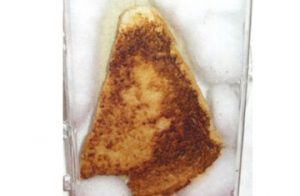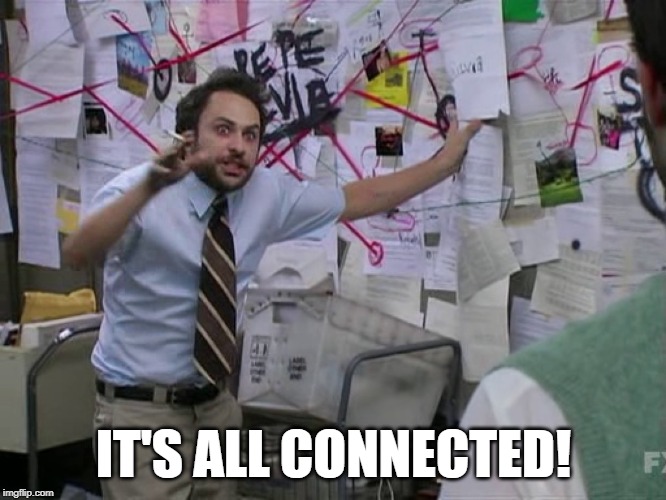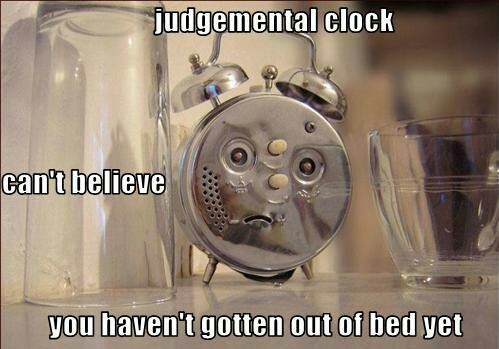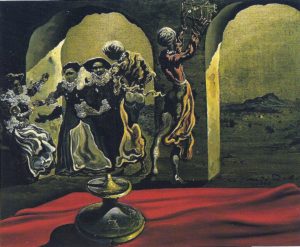Table of Contents (click to expand)
Apophenia is a phenomenon where people see patterns in randomness. While it is a normal human experience, it can become pathological in schizophrenia.
Would you believe me if I told you that a particular grilled cheese sandwich was sold for $28,000 on eBay?
Well, it’s true!
In 2004, a sandwich reverently preserved for 10 years by a Florida woman was sold at that unbelievably high price because some viewers claimed to see an image of the Virgin Mary in the toasted bread (Source).

Humans seem to find it harmless or even delightful to entertain these fancies – pointing out the man in the moon, identifying familiar shapes in clouds or even in the dirt left on cars. We enjoy searching for patterns in randomness.
In fact, recognizing patterns is one of our most basic cognitive skills and has been crucial for our survival and evolution. Our hominid ancestors recognized both food and predators using pattern recognition. When they heard a rustle, their pattern recognition skills alerted them to consider if the movement was because of wind or some hungry predator waiting to pounce on them from the shadows. Similarly, when they saw an S-shaped root on the ground, it was their basic instinct that made them connect it with the image of a poisonous snake.
Our brain has been prepared to hunt down patterns since the snapshot of birth. Whether this relates to situations or objects, we have been programmed to find links and attach meaning to everything. We love to connect the dots and say that something happened because of something. However, is our brain always right? Do the patterns always exist in reality?

While pattern recognition is a really cool feature of our brain, unfortunately, it did not evolve a baloney-detection mechanism that could distinguish between true and false patterns. The patterns that our brains find do not always turn out to be meaningful in reality.
Have you ever jumped when a leaf scratched the back of your neck, but you immediately thought it was a spider? Have you ever heard voices in the random sounds generated by electronic devices, or linked conspiracies to the daily news? Many times, our pattern recognition system misfires and scares us without genuine cause.
What Is Apophenia?
The tendency of our brain to mistakenly detect patterns where they don’t exist is called ‘Apophenia’ (also called ‘patternicity’). This phenomenon makes us see connections between unrelated things and incidences of our life, and interpret them as being meaningful. The term ‘Apophenia’ was coined by the German neurologist, Klaus Conrad, who originally described this phenomenon as a psychotic thought process, and as one of the symptoms of schizophrenia. However, it is now viewed as a ubiquitous feature of human nature.
Imagine the following scenario: On a Monday morning, your alarm clock does not wake you up and you’re late for a very important meeting. Your cat has left your living room in an absolute mess. The coffee maker suddenly stopped working. It’s raining heavily and your car won’t start. What would you think, given this string of incidents? One or two of these minor events would seem insignificant, but once the list grows, it all looks like some sinister plot – a scheme of evil unseen forces conspiring against you.

Also Read: What Is Aphantasia?
Does Your Brain Choose Apophenia?
When in doubt, would you rather choose to believe a pattern or discard it? As it turns out, our brains will always choose to be on the safe side and believe the signs instead of ignoring them. A simple thought experiment may help you understand why.
Consider this: You are a hominid walking in the African jungle three million years ago. You suddenly hear a rustle in the grass. Is it the wind or a hungry predator? You have two obvious choices: You can assume (a) that the noise was just wind and go about your business, or (b) believe that the noise was indeed a predator, and seek shelter! If you assume that the noise is a predator, but it turns out to simply be the wind, you have nothing to lose. However, if you assume that it is just the wind and it turns out to be a predator, it may cost you your life.
Therefore, our brain chooses false positives (believing something to be real when it actually isn’t) over false negatives (not believing something as real when it actually is).
Also Read: Why Do We See Faces In Things?
Types Of Apophenia
Apophenia manifests itself in the following basic types:
Pareidolia
The most common variety of all, pareidolia, can be called visual apophenia. When we see something, our brain uses prior knowledge, context and expectations to make sense of it. That is why we frequently see non-existent things in sandwiches, clouds, dirt, etc. Moreover, since faces are the most common sights in our memory, we see faces in just about everything.

Gambler’s Fallacy
Gamblers often think that they see patterns in the numbers that appear in roulette wheels and lotteries. A common belief is that a particular outcome is ‘due’ to happen since it has not happened before, or vice versa. For example, imagine that Dave is repeatedly flipping a coin and guessing the outcome before it lands. After observing three heads in a row, he believes that a tail is ‘due’, meaning that a tail is more likely to appear on the next flip than a head. This is the gambler’s fallacy.
This phenomenon has highly contributed to the more than nine billion dollars in gambling revenue taken in by Nevada casinos in 2001 (Source).
Confirmation Bias
This is a cognitive bias that makes us seek and favor information that confirms our previously existing beliefs, while neglecting the clear evidence that would argue against those beliefs. We will not only seek information that supports our bias, but also remember details in a way that reinforces it. Confirmation bias is what we commonly call cherry-picking.
Middle-aged critics of modern youth will constantly look for evidence that confirms their beliefs that the new generation is lazy, ill-mannered and spoiled. A scientist will pay more attention to the data that confirms his/her pet theory and ignore (or put less weight on) the data that questions or contradicts it.
This type of bias can prevent us from looking at situations objectively and lead to poor or faulty choices.
Is Apophenia Dangerous?
While it’s tempting to view apophenia as just another defect in our cognitive capabilities, it might be useful for us to look beyond that dismissive stance and see it as an amusing aspect of nature. Good novelists understand this very well, and are therefore able to use seemingly unrelated associations to create suspense and anticipation in their readers.
Apophenia can be a boon to artists of any kind. Inspiration for a melody may come from a birdsong. If not for apophenia, we would be unable to appreciate puns and clever turns of phrase. Even Salvador Dali created magic in his paintings by playing with pareidolia!

Mild apophenia is not dangerous, per se; it is a normal human experience. Even so, it can become pathological in schizophrenia, when pattern recognition and interpretation run wild.
For the most part, it seems that our relentless quest for meaning in every routine aspect of life is a part of our larger search—a search for the meaning of our existence – one that is destined to go on for eternity.
How well do you understand the article above!

References (click to expand)
- Beitman, B. D. (2009, May). Brains Seek Patterns in Coincidences. Psychiatric Annals. SLACK, Inc.
- Cook, C. L. (2012, January 1). Book Review: The Human Brain as an Evolved Rationalization Machine. Evolutionary Psychology. SAGE Publications.
- Pareidolia - Indiana University Libraries. Indiana University Bloomington
- Do You See What I See? I See Jesus in Toast!. Colby College
- Gambler's Fallacy. Duke University
- CONFIRMATORY BIAS - www.indiana.edu:80
